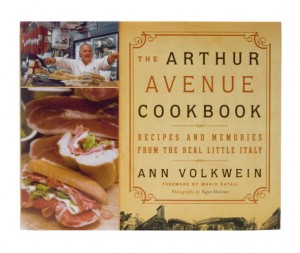Inside The New York Botanical Garden
The Edible Garden
Posted in Exhibitions, The Edible Garden on July 16 2009, by Plant Talk
 |
Kristin Schleiter is Curator of Outdoor Gardens and Herbaceous Collections. |
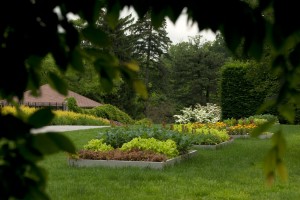 Have you been toying with the idea of starting a vegetable garden but you aren’t sure just how to do it? The Beginner’s Vegetable Garden, across from the Ruth Rea Howell Family Garden, is the perfect place to learn the basics. We planted popular vegetable varieties like ‘Early Girl’ tomatoes and jalapeno peppers in simple raised beds that receive sun all day long. We used a number of different easy-to-find support structures to give you ideas that you might want to try at home.
Have you been toying with the idea of starting a vegetable garden but you aren’t sure just how to do it? The Beginner’s Vegetable Garden, across from the Ruth Rea Howell Family Garden, is the perfect place to learn the basics. We planted popular vegetable varieties like ‘Early Girl’ tomatoes and jalapeno peppers in simple raised beds that receive sun all day long. We used a number of different easy-to-find support structures to give you ideas that you might want to try at home.
We are growing cucumbers on a frame, a large square grid of heavy gauge wire that is propped up on one side. The frame allows the cucumbers to hang down freely from the vines ensuring perfectly shaped vegetables. It also increases air circulation around the plant, which helps to minimize diseases like mildew. Cucumbers and squash both can take up a lot of real estate, so if you have limited space, this frame lets you grow them and still have room for other plants in the garden.
Pole bean seeds are planted at the base of bean towers and spirals, which will offer the plants strong support so they can grow tall, which allows for an easy harvest while again ensuring good air circulation. When your beans reach the top of their support, snip off the growing tip to encourage the plant to produce side branches. It is best not to work around bean plants or to pick beans when they are wet to prevent the spread of disease.
Read More
Posted in Shop/Book Reviews, The Edible Garden on July 15 2009, by Plant Talk
 |
Richard Pickett is Director of Retail Operations. |
At your next family reunion picnic you may run into some long lost relatives. Perhaps you’d think distant cousins, twice removed on your mother’s side, but in fact Lazy Housewife, Radiator Charlie, and Collective Farm Woman are beans, tomatoes and melons, respectively, more likely to be found on your plate next to grandma’s famous potato salad than out back bobbing for apples or spitting watermelon seeds.
By definition, heirloom vegetables are vintage varieties that have been preserved by passing seeds down from generation to generation. Heirlooms have often been selected for taste, appearance, and eating quality, and the demand for heirloom vegetables is rapidly increasing, especially among gardeners looking for unique flavors and freshness. While many heirloom vegetables are now available at farm stands, varieties of tomatoes, beans, and cucumbers are the most popular.
Among edible heirlooms literally thousands of varieties are available, many handed down, others swapped with fellow gardeners, and a growing number purchased from the ever-expanding selection of specialty seed purveyors. For The Edible Garden, the Home Gardening Center’s Lois Loeb Vegetable Garden has been redesigned by Rosalind Creasy into New York’s best heirloom vegetable garden. Using seeds from Seed Savers Exchange, this garden features a bountiful array of beautiful and delicious heirloom vegetables, herbs, and edible flowers. Seed Savers Exchange is the foremost organization dedicated to preserving agricultural diversity through the preservation and sharing of heirloom seeds.
At Shop in the Garden, we offer a wide variety of heirloom seeds, exclusively from Seed Savers Exchange, as well a great selection of heirloom tomato, pepper, and eggplant seedlings. You can also find fabulous garden gear online. So whether you are a longtime heirloom vegetable advocate (and there are many) or simply a home gardener looking for more variety, flavor, and excitement in your harvest basket, give heirloom vegetables a try. Who knows, in our hectic day-to-day existence, it may just be time to find the Lazy Housewife in all of us.
Posted in Exhibitions, The Edible Garden on July 7 2009, by Plant Talk
 Carol Capobianco is Editorial Content Manager at The New York Botanical Garden.
Carol Capobianco is Editorial Content Manager at The New York Botanical Garden.
Arthur Avenue.
Those two words conjure up so many sights, sounds, smells, and flavors all having to do with great food—Italian, that is.
As a kid growing up in the neighborhood I remember seeing round men with a napkin about their neck dousing raw clams with hot sauce and then slurping them down. I remember hearing the cacophony of clucking, caged chickens awaiting their turn with the butcher at the fresh poultry and rabbit market.
And the smells of the beloved “real Little Italy” were overwhelming and everywhere: fresh bread from the bakeries, sausage and peppers grilling at the street feasts, and from open apartment windows, tomato sauce (or “gravy” as we called it) simmering away.
But it was the flavors—and the quality—that are most reminiscent and what still brings me and countless others back to the area. The melt-in-your-mouth ravioli and fresh mozzarella, the sharp cheeses and imported prosciutto, the fine cuts of meat and the specialty fish, the incomparable breads and pastries, the strong espresso coffee.
And for those who don’t cook or who want to taste Italian food at its best in America, there are the restaurants, with menus filled with so many delicious meals that just reading the choices makes your mouth water. When I take my first bite into a dish made at these places, I can’t help but close my eyes and sigh with appreciation for these superior, soulful foods that can be savored right here in New York—and so close to The New York Botanical Garden.
Some of these delectables will be available for you to sample this Thursday from 6 to 9 p.m. at A Taste of Arthur Avenue, the first of seven Edible Evenings planned during The Edible Garden.
If you’d like to try your own hand at cooking some of the special dishes found on Arthur Avenue, you’ll find dozens of recipes in The Arthur Avenue Cookbook carried at Shop in the Garden.
Posted in Exhibitions, Programs and Events, The Edible Garden on July 3 2009, by Plant Talk
 |
Andrew Haight is Manager of the Everett Children’s Adventure Garden. |
Maps have always captured children’s imagination. Growing up I had every intention of becoming the next Indiana Jones. I hunted down buried “treasures” in my parent’s basement and made my own maps. I carefully crinkled the sheets, even tearing the corners to make the paper maps appear from “olden times.” The mystery and excitement seemed trapped on these sheets of paper; I felt they could lead me to new adventures.
This summer as part of The Edible Garden, maps will play a central role as we focus on the adventure in the Everett Children’s Adventure Garden through Flower Power!
Visitors can embark on their own journey through a series of activities laid out as a map inside each child’s field notebook. For instance, the map points out where a family can stop and make a pollinator puppet to take home and also guides children to several different activity and play stations, including a spot where they can mold their own flower out of clay.
The map allows children to choose their own route. Along the way they can discover the larger-than-life flower models, detour through Beth’s Maze, or simply take their time to explore each nook and cranny of the Garden. With the reins in each child’s hands in the form of a map, the possibilities are endless.
For more Edible Garden events and weekend activities, click here.
Posted in Exhibitions, The Edible Garden on July 2 2009, by Plant Talk
I’m a self-proclaimed minimalist. I don’t really know how it happened (a result, most likely, of having moved 16 times in the past 10 years), but it has permeated all parts of my life, including my kitchen. Despite that, I’ve always made space for some homegrown produce in my life—or on my windowsill, to be more precise. And having a garden to eat from is the basis of how I learned to cook, a reality that’s not easy for anyone. (It helps that my home region of Southern California is an agricultural utopia where nearly anything will grow anytime of year). And while I’ve never had enough space to sow a full garden, the idea of eating as fresh and as in season as possible has stuck with me.
With green, sustainable, and local as the buzzwords du jour, it can become intimidating figuring out how, if at all, it can work for you. All that moving I’ve done and all the creative ways people have embraced those tenets in my current hometown of San Francisco has led me to this conclusion: Make sure whatever you do works with your lifestyle, and you’ll be more likely to stick with it in the long term. There are plenty of resources out there for the gung ho: you can get a subscription to a CSA (Community Supported Agriculture), get a plot in a community garden, or just support your local farmer or grocer who you think is doing it right.
And, there’s a huge upside for the food obsessed—you and your family start to learn a lot about ingredients you once may have considered mundane (like that Brussels sprouts grow on stalks, that chickpeas are tasty fresh, that freshly grown cucumbers actually have taste, or even that kids will eat freshly picked tomatoes like candy once they’ve experienced how sweet they actually are).
Read More
Posted in Exhibitions, The Edible Garden on July 1 2009, by Plant Talk
 |
Nick Leshi is Associate Director of Public Relations and Electronic Media. |
With gorgeous weather and in front of enthusiastic crowds, Martha Stewart and Dan Barber were among the celebrities who kicked off the opening of The Edible Garden summer-long exhibitions this past Saturday at The New York Botanical Garden. You may have seen some of the coverage on NY1 News, WABC-TV, WCBS-TV, or WNBC-TV, or you may have read about it in New York magazine, The New York Times, New York’s Daily News, or online at Daily Kos and dozens of blogs.
Those of you who were here in person witnessed Martha Stewart and her friends answering audience questions about the Culinary Herb Garden they designed and demonstrating how to make delicious cocktails using homegrown herbs. Dan Barber, winner of the James Beard Foundation 2009 Outstanding Chef Award, captivated visitors with his insightful presentation about the farm-to-table movement. Other special guests who appeared on the Conservatory Kitchen stage during the opening weekend, providing delectable cooking demonstrations, were: Johnny Iuzzini, Michael Anthony, Peter Hoffman, Aida Mollenkamp, and Michel Nischan. Recipes by some of The Edible Garden participants can be found on our Web site. Thanks to all of our sponsors for helping make it all possible.
Other attractions included lectures by Amy Goldman on Heirloom Tomatoes and Rosalind Creasy on Gardening with Heirloom Flowers and Vegetables. There were booksignings, home gardening demonstrations, and tours—all part of the Botanical Garden’s continuing efforts to showcase edible plants as economical, nutritious, and good for the environment.
If you missed the opening weekend, you can still experience The Edible Garden throughout the summer until September 13. Multiple exhibitions are on display across the Garden’s 250 acres, including Tropical Fruits, Roots, and Shoots in the Enid A. Haupt Conservatory and Vegetables and Kids in the Ruth Rea Howell Family Garden, to name just two. Other highlights of The Edible Garden include an Edible Audio Tour narrated by Mario Batali and others, Edible Evenings for seven Thursday nights beginning July 9, the Farmers Market all day every Wednesday and Saturday, and a closing weekend festival to wrap it all up on September 12 and 13.
For all the details and to purchase tickets, visit our Edible Garden Web pages.
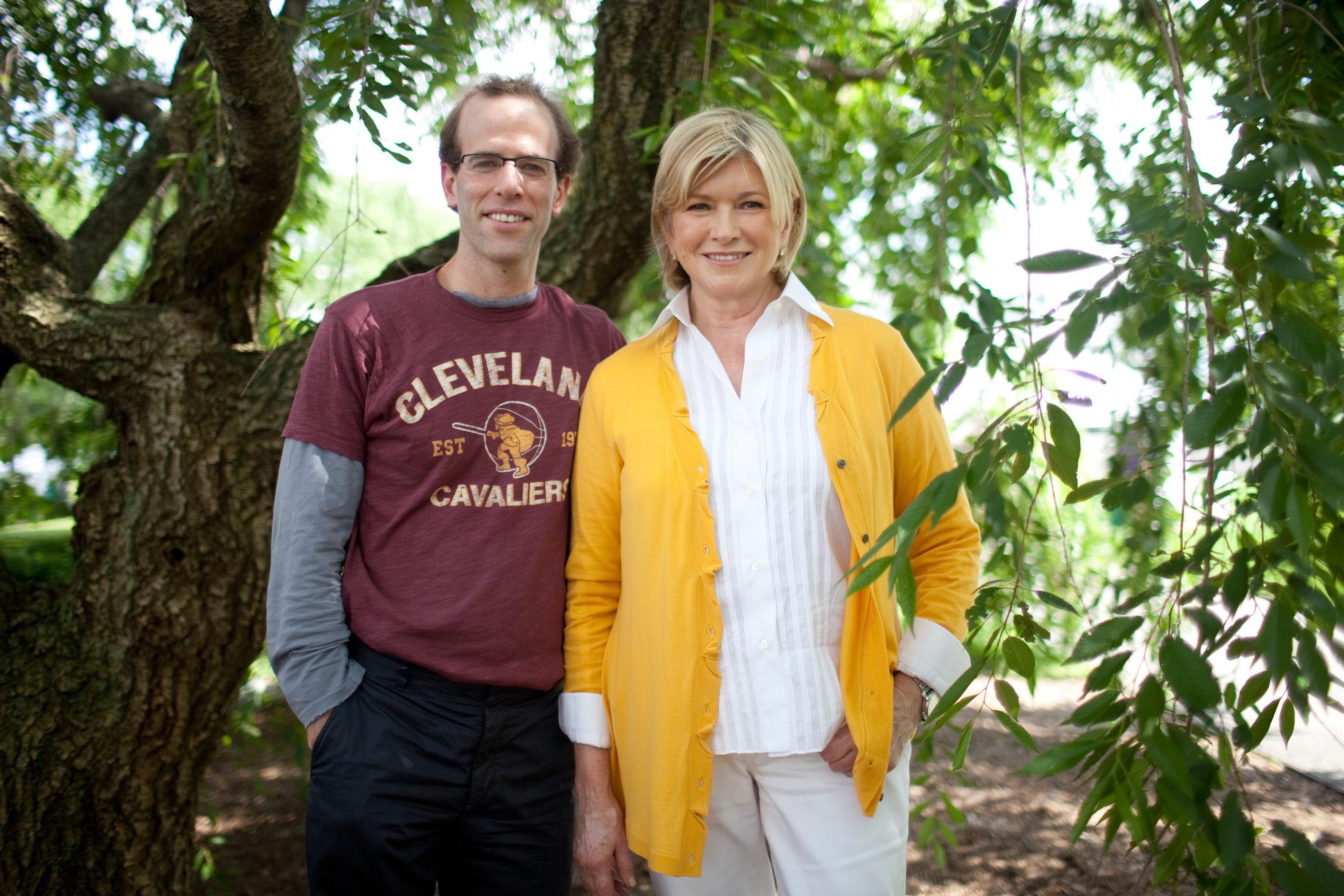
Posted in Exhibitions, The Edible Garden on June 26 2009, by Plant Talk
Martha Stewart Heads Lineup of Celebrities, Chefs
 Jennifer Josef is Director of Public Education.
Jennifer Josef is Director of Public Education.
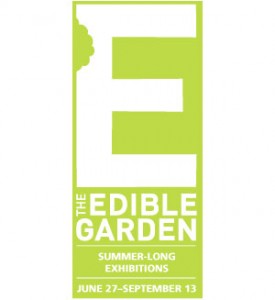 At long last all these months of planning are coming to fruition: from the amazing signs and information that interpret the special garden exhibitions to the fun and interesting programs happening on Saturday and Sunday and beyond. The Edible Garden finally opens.
At long last all these months of planning are coming to fruition: from the amazing signs and information that interpret the special garden exhibitions to the fun and interesting programs happening on Saturday and Sunday and beyond. The Edible Garden finally opens.
Coming from an Italian family, food and cooking have always been a large part of my life. Some of my fondest childhood memories are of times spent with my mom in our garden or in the kitchen cooking together. I think that’s why The Edible Garden resonates with so many people—we all have had great experiences that involve food.
With the amazing lineup of chefs, gardening experts, and scientists, The Edible Garden takes growing and cooking great food to another level. This weekend I look forward to learning about heirloom vegetables with author Amy Goldman and then how to save their seeds from George DeVault, President and Executive Director of Seed Savers Exchange, to get my own container garden growing in my apartment. Thank goodness Sonia Uyterhoeven, Gardner for Public Educaiton, leads the Home Gardening Demonstrations on the weekends: She always answers my beginner questions with ease, although I’m sure she must get a laugh out of my wacky questions.
I had the privilege of meeting Dan Barber, chef at Blue Hill at Stone Barns, during our interview for the Edible Audio Tour; he was amazing. Secretly (or not so secretly now!), I have developed a crush on him. His passion about great food and the local food movement is inspirational. I can’t wait to hear more from him about his own work and where we as consumers can take the food movement. He’ll be presenting in the Conservatory Kitchen on Saturday.
And who doesn’t love a cocktail! I feel sure I’ll be able to re-create some of the cocktails Martha Stewart will be making during her demonstration on Saturday. Her recipes, along with others, will be posted on the Botanical Garden’s Web site, so no need to take notes while enjoying her “Cocktail Hour.” While I haven’t managed to eat at Savoy yet, I’m positive that owner and chef Peter Hoffman will show us recipes that will whet my appetite and have me calling up for reservations right after he finishes his Sunday demonstration!
 Speaking of recipes, at our Media Preview on Wednesday, Chef Dan Rothman from Whole Foods Market, one of our sponsors, put our new Conservatory Kitchen to use. He whipped up a Rainbow Chard Slaw with Yarrow-Berry Vinaigrette for those in attendance, choosing his ingredients especially for their seasonality—what can be found at this time of year in home gardens or at farmers markets. Try it out and tell us how you like it.
Speaking of recipes, at our Media Preview on Wednesday, Chef Dan Rothman from Whole Foods Market, one of our sponsors, put our new Conservatory Kitchen to use. He whipped up a Rainbow Chard Slaw with Yarrow-Berry Vinaigrette for those in attendance, choosing his ingredients especially for their seasonality—what can be found at this time of year in home gardens or at farmers markets. Try it out and tell us how you like it.
We have been working with these and other amazing people for many months now in planning The Edible Garden. Like with any good meal preparation, the moment comes when it’s time to “dig in.” So please come, dig in, and enjoy this celebration of food and return throughout the summer for more fun events.
Posted in Exhibitions, Shop/Book Reviews, The Edible Garden on June 24 2009, by Plant Talk
 John Suskewich is Book Manager for Shop in the Garden.
John Suskewich is Book Manager for Shop in the Garden.
With apologies to Cicero but with respect to American eating habits: O tempura! O morels!
The Western diet—based on fats, processed foods and convenience foods, and industrialized agriculture—may be responsible for a host of ills. In the last hundred years or so, it “has changed in ways that are making us increasingly sick and fat,” one food journalist recently commented. Ever more frequently and from many quarters, it is being questioned, rethought, reinvented. So it is that The Edible Garden, the Botanical Garden’s summer-long celebration of growing, preparing, and eating great food, comes at a propitious moment. With the current debate and state of eating in the United States, what do our on-site exhibitions bring to the table? Here are a few sources for perspective on this issue.
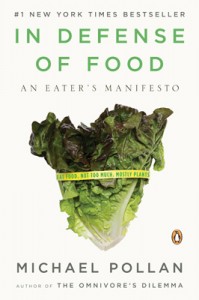 Journalist/gardener Michael Pollan is one of the pioneers in sounding the alarm about the American diet. His most recent book, In Defense of Food, argues thoroughly, convincingly, and very readably that good health will come when we reject the current reliance on fast food, food substitutes, food byproducts, engineered food, overpackaged food, overprocessed food, or any comestible with an adjective attached. His manifesto is very close to the mission of this institution—to be an advocate for the plant kingdom—and it boils down to: “Eat food. Not too much. Mostly plants.”
Journalist/gardener Michael Pollan is one of the pioneers in sounding the alarm about the American diet. His most recent book, In Defense of Food, argues thoroughly, convincingly, and very readably that good health will come when we reject the current reliance on fast food, food substitutes, food byproducts, engineered food, overpackaged food, overprocessed food, or any comestible with an adjective attached. His manifesto is very close to the mission of this institution—to be an advocate for the plant kingdom—and it boils down to: “Eat food. Not too much. Mostly plants.”
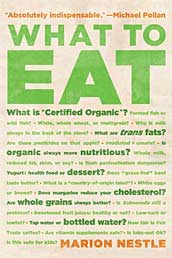 What to Eat by Marion Nestle takes this advice and turns it into a field guide for the supermarket. What is fresh, organic, low fat, reduced fat, no fat, trans fat, polyunsaturated fat, fat free?? For the consumer trying to “do the right thing,” the grocery chain is ground zero in the food chain, but it is a mine field, with marketing, packaging, and processing tripwires that can land you with eggbeaters all over your face. What to Eat analyzes the claims, counterclaims, labels, small print, jargon, subtext, and easy-open cartons to uncover the real truth about the dairy case and the frozen food aisle to make shoppers more savvy.
What to Eat by Marion Nestle takes this advice and turns it into a field guide for the supermarket. What is fresh, organic, low fat, reduced fat, no fat, trans fat, polyunsaturated fat, fat free?? For the consumer trying to “do the right thing,” the grocery chain is ground zero in the food chain, but it is a mine field, with marketing, packaging, and processing tripwires that can land you with eggbeaters all over your face. What to Eat analyzes the claims, counterclaims, labels, small print, jargon, subtext, and easy-open cartons to uncover the real truth about the dairy case and the frozen food aisle to make shoppers more savvy.
Read More

 Have you been toying with the idea of starting a vegetable garden but you aren’t sure just how to do it? The Beginner’s Vegetable Garden, across from the Ruth Rea Howell Family Garden, is the perfect place to learn the basics. We planted popular vegetable varieties like ‘Early Girl’ tomatoes and jalapeno peppers in simple raised beds that receive sun all day long. We used a number of different easy-to-find support structures to give you ideas that you might want to try at home.
Have you been toying with the idea of starting a vegetable garden but you aren’t sure just how to do it? The Beginner’s Vegetable Garden, across from the Ruth Rea Howell Family Garden, is the perfect place to learn the basics. We planted popular vegetable varieties like ‘Early Girl’ tomatoes and jalapeno peppers in simple raised beds that receive sun all day long. We used a number of different easy-to-find support structures to give you ideas that you might want to try at home.


